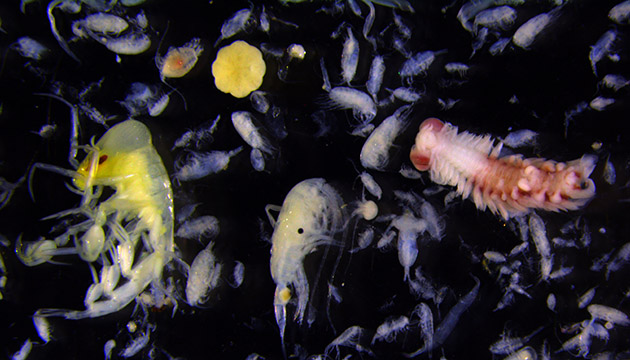Posted in:
Small but Mighty…and Seasonal!

Earlier this year, BIOS associate scientist and zooplankton ecologist Leocadio Blanco-Bercial published a paper in the scientific journal Frontiers in Marine Science that sheds light on zooplankton communities in the Sargasso Sea, where zooplankton diversity is among the highest in the world’s ocean.
“The diversity and specific composition of zooplankton communities have a direct effect on the ecosystem services, such as carbon export, and structure of ocean food webs,” Blanco-Bercial said. However, in areas where diversity is high, scientists have traditionally lacked the time, resources, and techniques to fully characterize zooplankton communities.
Since 1988, the Bermuda Atlantic Time-series Study (BATS) has allowed scientists to collect a suite of oceanographic measurements from a research area located in the Sargasso Sea approximately 50 miles southeast of Bermuda. These data include a variety of chemical oceanography measurements, such as temperature, salinity, and total carbon dioxide, as well as biological oceanography measurements of bacterial activity and primary production.
In the late 1960s and early 1970s, zooplankton ecologists Georgiana Deevey and A.L. Brooks identified more than 300 species of copepods in the Sargasso Sea, but noted that time and classification issues prevented identification of many smaller species. Since then, additional studies have been carried out in the region, but have focused on major taxonomic groups or zooplankton processes and biogeochemical cycling. Blanco-Bercial’s research, funded in part by the BIOS Simons Collaboration on Ocean Processes and Ecology (BIOS-SCOPE) study of microbial oceanography in the North Atlantic Ocean, represents the most comprehensive investigation into zooplankton community composition at the BATS site.
“In the last two decades, molecular markers have been developed for species identification, an approach commonly known as barcoding,” Blanco-Bercial explained. Nowadays, these sequencing processes have become automated and are known as “high throughput sequencing,” allowing scientists to sequence hundreds of millions of DNA samples at a time. When conducted at the community level, this approach is known as “metabarcoding” and helps researchers uncover species diversity, community structure within the open ocean, and how communities shift with changes in environmental conditions.
Using zooplankton samples collected during both the day and night from BATS research cruises in 2015 and early 2016, Blanco-Bercial demonstrated that zooplankton communities at the BATS site are influenced by the seasons, with four distinct seasonal communities present that are characterized by varying abundances of key zooplankton species. Oceanographers have long known about predictable community shifts, called blooms, that occur during winter and spring mixing events in the open ocean; however, this new research sheds light on the more gradual community transitions that occur from spring/early summer to summer, and fall to winter.
These changes in structure also have implications for how the various zooplankton species work within the ecosystem—a component of biodiversity known as “functional diversity.” Blanco-Bercial’s analyses showed that omnivorous zooplankton were able to increase their populations quickly in response to phytoplankton blooms, while those species that feed only on phytoplankton were slower to respond.
“This suggests that zooplankton with a wider variety of prey might have an advantage in this region,” he said. “It also might explain why zooplankton are able to maintain larger populations in the fall and winter months, when nutrient resources are low.” Additionally, these differences in functional diversity might affect ecosystem processes such as carbon flux, whereby the plankton help transfer carbon dioxide from the atmosphere to the deep ocean. This highlights the need for further studies of functional biodiversity in order to better understand and characterize regional ecosystem processes and biogeochemical cycling.
Tagged: